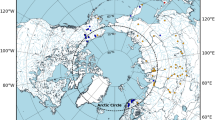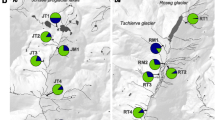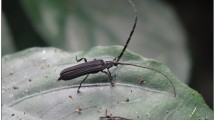Abstract
A decreasing population size is often causing species extinction, however, relict species persisting in small-sized populations counter this. We analysed spatial genetic variation and past changes in population size at the maternally-inherited mitochondrial DNA level to clarify the origin of all recently known isolated populations of Pholidoptera frivaldskyi occurring in the range of Carpathian Mountains. Along with that we analysed also morphological variation as some phenotypic traits can retain useful information on population genetic structure. We found a relatively low genetic diversity within isolated populations as 778 bp COI gene sequences revealed only 13 unique haplotypes (n = 173 individuals from 10 populations). The spatial analysis of molecular variance identified three geographically homogenous genetic clusters (one in Slovakia and two in Romania) with a high level of differentiation among them, suggesting restricted gene flow, whilst Bayesian skyline simulation reconstructed a negative demographic change through evolutionary time. Inferred genetic pattern clearly coincides with differences in males’ colour phenotype as the extent of pigmentation on the lateral pronotum varied significantly among genetic lineages. We suggest that geographical variation in the species populations has relict-like character and their isolated occurrence is not a result of recent introduction events. Identification of ‘evolutionary units’ may help in the conservation and management of this rare insect species.



Similar content being viewed by others
References
Albrecht H, Haider S (2013) Species diversity and life history traits in calcareous grasslands vary along an urbanization gradient. Biodivers Conserv 22:2243–2267
Ashcroft MB (2010) Identifying refugia from climate change. J Biogeogr 37:1407–1413
Avise JC (2000) Phylogeography: the history and formation of species. Harvard University Press, Cambridge
Barascud B, Martin JF, Baguette M, Descimon H (1999) Genetic consequences of an introduction-colonization process in an endangered butterfly species. J Evol Biol 12:697–709
Britten HB, Brussard PF, Murphy DD (1994) The pending extinction of the Uncompahgre fritillary butterfly. Conserv Biol 8:86–94
Brouwers NC, Newton AC (2009) The influence of habitat availability and landscape structure on the distribution of wood cricket (Nemobius sylvestris) on the Isle of Wight, UK. Landsc Ecol 24:199–212
Chobanov D, Mihajlova B (2010) Orthoptera and Mantodea in the collection of the Macedonian Museum of Natural History (Skopje) with an annotated check-list of the groups in Macedonia. Articulata 25:73–107
Cicconardi F, Nardi F, Emerson BC, Frati F, Fanciulli PP (2010) Deep phylogeographic divisions and long-term persistence of forest invertebrates (Hexapoda: collembola) in the North-Western Mediterranean basin. Mol Ecol 19:386–400
Çiplak B (2004) Systematics, phylogeny and biogeography of Anterastes (Orthoptera, Tettigoniidae, Tettigoniinae): evolution within a refugium. Zool Scr 33:19–44
Coope GR (1994) The response of insect faunas to glacial-interglacial climatic fluctuations. Philos Trans R Soc B 344:19–26
Darriba D, Taboada GL, Doallo R, Posada D (2012) jModelTest 2: more models, new heuristics and parallel computing. Nat Methods 9:772
di Castri F (1989) History of biological invasions with emphasis on the Old World. In: Drake J, di Castri F, Groves R et al (eds) Biological invasions: a global perspective. Wiley, New York, pp 1–30
Diekötter T, Csencsics D, Rothenbühler C, Billeter R, Edwards PJ (2005) Movement and dispersal patterns in the bush cricket Pholidoptera griseoaptera: the role of developmental stage and sex. Ecol Entomol 30:419–427
Drummond AJ, Rambaut A (2007) BEAST: Bayesian evolutionary analysis by sampling trees. BMC Evol Biol 7:214
Drummond AJ, Rambaut A, Shapiro B, Pybus OG (2005) Bayesian coalescent inference of past population dynamics from molecular sequences. Mol Biol Evol 22:1185–1192
Dupanloup I, Schneider S, Excoffier L (2002) A simulated annealing approach to define the genetic structure of populations. Mol Ecol 11:2571–2581
Ebner R (1914) Beiträge zur Kenntnis der Orthopteren – Fauna von Österreich-Ungarn (IV. Hohe Tatra). Int Entomol Ztschr 7:309–312
Excoffier L, Lischer HEL (2010) Arlequin suite ver 3.5: a new series of programs to perform population genetics analyses under Linux and Windows. Mol Ecol Resour 10:564–567
Fabriciusová V, Kaňuch P, Krištín A (2008) Body size patterns of Pholidoptera frivaldskyi (Orhtoptera) in very isolated populations. J Orthoptera Res 17:171–176
Fauvergue X, Vercken E, Malausa T, Hufbauer RA (2012) The biology of small, introduced populations, with special reference to biological control. Evol Appl 5:424–443
Garnier S, Alibert P, Audiot P, Prieur B, Rasplus JY (2004) Isolation by distance and sharp discontinuities in gene frequencies: implications for the phylogeography of an alpine insect species, Carabus solieri. Mol Ecol 13:1883–1897
Grant WS, Liu M, Gao T, Yanagimoto T (2012) Limits of Bayesian skyline plot analysis of mtDNA sequences to infer historical demographies in Pacific herring (and other species). Mol Phylogenet Evol 65:203–212
Griebeler EM, Gottschalk (2010) Conservation of the grey bush cricket Platycleis albopunctata (Orthoptera: Tettigoniidae) under differing habitat conditions: implications from an individual-based model. In: Habel JC, Thorsten A (eds) Relict species. Springer, Berlin, pp 385–399
Grimaldi D, Engel MS (2005) Evolution of the insects. Cambridge University Press, Cambridge
Habel JC, Augenstein B, Meyer M, Nève G, Rödder D, Assmann T (2010) Population genetics and ecological niche modelling reveal high fragmentation and potential future extinction of the endangered relict butterfly Lycaena helle. In: Habel JC, Thorsten A (eds) Relict species. Springer, Berlin, pp 417–439
Hall TA (1999) BioEdit: a user-friendly biological sequence alignment editor and analysis program for Windows 95/98/NT. Nucl Acids Symp Ser 41:95–98
Hampe A, Jump AS (2011) Climate relicts: past, present, future. Annu Rev Ecol Evol Syst 42:313–333
Harz K (1969) Die Orthopteren Europas—The Orthoptera of Europe, vol I. Dr. W. Junk B.V, Hague
Ho SYW, Lanfear R, Bromham L, Phillips MJ, Soubrier J, Rodrigo AG, Cooper A (2011) Time-dependent rates of molecular evolution. Mol Ecol 20:3087–3101
Hochkirch A, Witzenberger KA, Teerling A, Niemeyer F (2007) Translocation of an endangered insect species, the field cricket (Gryllus campestris Linnaeus, 1758) in northern Germany. Biodivers Conserv 16:3597–3607
Holuša J (2012) Grasshoppers and bushcrickets regionally extinct in the Czech Republic: consequence of the disappearance of habitats scattered on the edge of their ranges. J Insect Conserv 16:949–960
Iorgu IŞ, Pisică E, Păiş L, Lupu G, Iuşan C (2008) Checklist of Romanian Orthoptera (Insecta: Orthoptera) and their distribution by ecoregions. Travaux du Muséum d’Histoire Naturelle “Grigore Antipa” 51:119–135
Kajtoch Ł, Lachowska-Cierlik D, Mazur M (2009) Genetic diversity of xerothermic weevils Polydrusus inustus and Centricnemus leucogrammus (Coleoptera: Curculionidae) in central Europe. Eur J Entomol 106:325–334
Kajtoch Ł, Kubisz D, Gutowski JM, Babik W (2014) Evolutionary units of Coraebus elatus (Coleoptera: Buprestidae) in central and eastern Europe – implications for origin and conservation. Insect Conserv Diver 7:41–54
Kaňuch P, Berggren Å, Cassel-Lundhagen A (2013) Colonization history of Metrioptera roeselii in northern Europe indicates human-mediated dispersal. J Biogeogr 40:977–987
Keller LF, Waller DM (2002) Inbreeding effects in wild populations. Trends Ecol Evol 17:230–241
Keller I, Nentwig W, Largiader CR (2004) Recent habitat fragmentation due to roads can lead to significant genetic differentiation in an abundant flightless ground beetle. Mol Ecol 13:2983–2994
Krištín A (2000) Zur Verbreitung und Ökologie der bedrohten Arten Arcyptera fusca und Pholidoptera frivaldskyi (Orthoptera) in der Slowakei. Linzer biol Beitr 32:753–761
Krištín A, Jarčuška B, Kaňuch P, Iorgu IŞ, Iorgu EI (2013) Notes on Orthoptera (Insecta) and their assemblages in the Romanian Carpathians. Travaux du Muséum d’Histoire Naturelle “Grigore Antipa” 56:19–32
Krzysztofiak L, Krzysztofiak A, Frąckiel K, Biała A, Kilikowska A, Sell J (2010) Genetic and morphological differentiation between isolated Polish populations of “glacial relict”, an endangered butterfly, Oeneis jutta (Lepidoptera: Nymphalidae). Eur J Entomol 107:115–120
Lande R (2009) Adaptation to an extraordinary environment by evolution of phenotypic plasticity and genetic assimilation. J Evol Biol 22:1435–1446
Librado P, Rozas J (2009) DnaSP v5: a software for comprehensive analysis of DNA polymorphism data. Bioinformatics 25:1451–1452
Łomnicki AM (1875) Materialy do fauny saranczakow galicyjskich. Spraw Kom Fizyjogr, Kraków 9:150–154
Łomnicki AM (1879) Zapisky ortopterologiczne. Spraw Kom Fizyjogr, Kraków 13:124–129
Lynch M (2010) Evolution of the mutation rate. Trends Genet 26:345–352
Nagy B (2005) Orthoptera fauna of the Carpathian basin—recent status of knowledge and revised checklist. Entomofauna Carpathica 17:14–22
O’Brien SM, Gallucci VF, Hauser L (2013) Effects of species biology on the historical demography of sharks and their implications for likely consequences of contemporary climate change. Conserv Gen 14:125–144
Ortego J, Bonal R, Cordero PJ, Aparicio JM (2009) Phylogeography of the Iberian populations of Mioscirtus wagneri (Orthoptera: Acrididae), a specialized grasshopper inhabiting highly fragmented hypersaline environments. Biol J Linn Soc 97:623–633
Ortego J, Aguirre MP, Cordero PJ (2012) Genetic and morphological divergence at different spatiotemporal scales in the grasshopper Mioscirtus wagneri (Orthoptera: Acrididae). J Insect Conserv 16:103–110
Palsbøll PJ, Berube M, Allendorf FW (2007) Identification of management units using population genetic data. Trends Ecol Evol 22:11–16
Phillipsen IC, Lytle DA (2013) Aquatic insects in a sea of desert: population genetic structure is shaped by limited dispersal in a naturally fragmented landscape. Ecography 36:731–743
Polus E, Vandewoestijne S, Choutt J, Baguette M (2007) Tracking the effects of one century of habitat loss and fragmentation on calcareous grassland butterfly communities. Biodivers Conserv 16:3423–3436
Ritchie MG, Kidd DM, Gleason JM (2001) Mitochondrial DNA variation and GIS analysis confirm a secondary origin of geographical variation in the bushcricket Ephippiger ephippiger (Orthoptera: Tettigonioidea), and resurrect two subspecies. Mol Ecol 10:603–611
Ronquist F, Teslenko M, van der Mark P, Ayres DL, Darling A, Höhna S, Larget B, Liu L, Suchard MA, Huelsenbeck JP (2012) MrBayes 3.2: efficient Bayesian phylogenetic inference and model choice across a large model space. Syst Biol 61:539–542
Schmitt T (2009) Biogeographical and evolutionary importance of the European high mountain systems. Frontiers Zool 6:art9
Schneider CA, Rasband WS, Eliceiri KW (2012) NIH Image to ImageJ: 25 years of image analysis. Nat Methods 9:671–675
Simon C, Frati F, Beckenbach A, Crespi B, Liu H, Flook P (1994) Evolution, weighting, and phylogenetic utility of mitochondrial gene sequences and a compilation of conserved polymerase chain reaction primers. Annals Entomol Soc Am 87:651–701
Stewart JR, Lister AM, Barnes I, Dalén L (2010) Refugia revisited: individualistic responses of species in space and time. Proc R Soc B Biol Sci 277:661–671
Storozhenko SA, Gorochov (1992) Contribution to the knowledge of the Orthopteran fauna of Ukrainian Carpathians (Orthoptera). Folia Entomol Hungar 52:93–96
Stucky BJ (2012) SeqTrace: A graphical tool for rapidly processing DNA sequencing chromatograms. J Biomol Tech 23:90–93
Teacher AGF, Griffiths DJ (2011) HapStar: automated haplotype network layout and visualisation. Mol Ecol Res 11:151–153
R Development Core Team (2011). R: a language and environment for statistical computing. R Foundation for Statistical Computing, Vienna. http://www.R-project.org/
Turnock D (2003) Settlement and sustainability in the Carpathians: pre-modern settlement history with particular reference to the role of pastoralism in Romania. Analele Universităţii de Vest din Timişoara, Geografie 13:91–114
Vickers K, Sveinbjarnardottir G (2013) Insect invaders, seasonality and transhumant pastoralism in the Icelandic shieling economy. Enviro Archaeo 18:165–177
Wagner C (2004) Passive dispersal of Metrioptera bicolor (Phillipi 1830) (Orthopteroidea: Ensifera: Tettigoniidae) by transfer of hay. J Insect Conserv 8:287–296
Warchałowska-Śliwa E, Michailova P (1993) Cytological study of Pholidoptera frivaldsky (Herm.) (Decticidae, Orthoptera). Cytobios 74:155–162
Warchałowska-Śliwa E, Heller K-G, Maryańska-Nadachowska A (2005) Cytogenetic variability of European Tettigoniinae (Orthoptera, Tettigoniidae): karyotypes, C-and Ag-NOR-banding. Folia Biol (Kraków) 53:161–171
Whitney KD, Gabler CA (2008) Rapid evolution in introduced species, ‘invasive traits’ and recipient communities: challenges for predicting invasive potential. Divers Distrib 14:569–580
Willi Y, Van Buskirk J, Hoffmann AA (2006) Limits to the adaptive potential of small populations. Annu Rev Ecol Evol Syst 37:433–458
Wilson JRU, Dormontt EE, Prentis PJ, Lowe AJ, Richardson DM (2009) Something in the way you move: dispersal pathways affect invasion success. Trends Ecol Evol 24:136–144
Acknowledgments
We would like to thank P. Tuček and M. Mikuš for helping us out in the field and for taking colour measurements of the studied individuals. Two anonymous reviewers are greatly acknowledged for valuable and insightful comments on a previous version of this manuscript. The study was financed by the Slovak Research and Development Agency (APVV-0497-10).
Author information
Authors and Affiliations
Corresponding author
Rights and permissions
About this article
Cite this article
Kaňuch, P., Jarčuška, B., Iorgu, E.I. et al. Geographic variation in relict populations: genetics and phenotype of bush-cricket Pholidoptera frivaldskyi (Orthoptera) in Carpathians. J Insect Conserv 18, 257–266 (2014). https://doi.org/10.1007/s10841-014-9636-6
Received:
Accepted:
Published:
Issue Date:
DOI: https://doi.org/10.1007/s10841-014-9636-6




